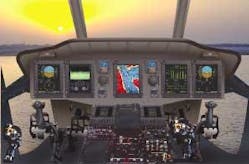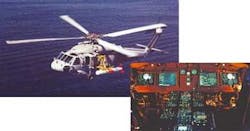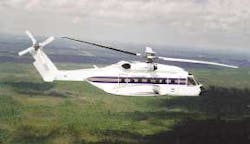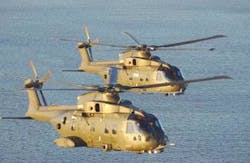Designers of avionics suites for U.S. military rotorcraft are turning toward commercial technology standards to upgrade the aviation electronics in these aircraft.
By John McHale
Helicopter designs have come a long way since Leonardo Davinci's rough sketchbook concepts 400 years ago. Some of today's most advanced whirlybirds are high-tech killing machines with brand new digital cockpits that take advantage of the best commercial technology in displays, processors, and sensors.
Military helicopter avionics designers are switching from their electronic architectures of the last 20 years, which are made up of gauges and dials, to what is commonly termed a glass cockpit of multifunction flat-panel displays. Glass cockpits feature sophisticated real-time operating-system software and the latest in processor technology to provide another popular military catch phrase, situational awareness.
The upgrades signal the move of the U.S. military's helicopter fleet to the glass cockpits of current commercial airliners, next-generation fighting planes such as the U.S. Air Force F/A-22 Raptor, the F-35 Joint Strike Fighter, and other military aircraft by embracing commercial standards and commonality. The latest high-speed PowerPC processors are as many as five or six generations ahead of the computers that make up some current helicopter avionics suites.
The improved reliability of commercial off-the-shelf (COTS) hardware and the open-architecture approach to combating component obsolescence has enabled avionics designers such as Lockheed Martin, Rockwell Collins, and Northrop Grumman to look at using high-performance processors and the latest in display technology for helicopter cockpit avionics upgrades.
Common cockpit
Commonality and commercial standards drive the U.S. Navy's Common Cockpit program, which supports the Navy's MH-60S and MH-60R multimission helicopters. "The Common Cockpit brings a fully integrated, certified cockpit common to both the MH-60R and MH-60S," says Paul Monseur, multimission helo systems director at Lockheed Martin Systems Integration–Owego in Owego, N.Y. "It provides the capability to expand as required, so the same cockpit will support the MH-60S armed helo and MH-60S airborne mine countermeasures (AMCM) mission with no change to the cockpit hardware."
Lockheed Martin–Owego is the systems integrator for the MH-60R and provides the common cockpit to all MH-60S and MH-60R helicopters. Sikorsky Aircraft Corp. in Stratford, Conn., designs and manufactures the MH-60S and MH-60R aircraft and is responsible for the mechanical and electrical modifications on the airframes. The MH-60S cockpit is a being installed in a new aircraft, Monseur adds.
To date "70 cockpits, plus spares, have been delivered and a total of 61 MH-60S aircraft have been fielded to date with the Common Cockpit," Monseur says. "The MH-60S with the common cockpit has already seen operational service as part of Operation Iraqi Freedom." The MH-60R is in the final stages of development test and is scheduled to enter the technology-evaluation phase this fall.
The Common Cockpit contract is for 172 systems for MH-60S and MH-60R helicopters over five years, with an option for 71 common cockpits. "The MH-60S avionics are based on commercial standards including the displays, data-entry devices, audio management system, and processing hardware," Monseur says. The processor is a dual-redundant flight-management computer from Lockheed Martin–Owego. It is a 6U VME architecture using PowerPC processing and a VxWorks real-time operating system from Wind River Systems in Alameda, Calif. Primary data networks include MIL-STD-1553, Fibre Channel, Ethernet, SCSI, and ARINC 429.
"Data storage is provided by a Kaman data-transfer system that supports dual PCMCIA cards, with data provided over a SCSI," Monseur continues. A PowerPC-based keyset from Smiths Industries supports data entry for each operator. The displays are PowerPC-based 8-by-10-inch liquid-crystal displays from Northrop Grumman, with separate mission and flight displays for each operator. The audio management system is a VME-Based PowerPC architecture from Telephonics in Farmingdale, N.Y., with 24 audio channel support.
"The base version of the MH-60S does not have any sensors," Monseur says. The MH-60S, MH-60R, armed helo, and AMCM variants use the same cockpit with integrated sensors. Each of these platforms uses not only the same hardware, but also an identical software base.
The U.S. Navy recently awarded Lockheed Martin a five-year contract for Common Cockpits. "This contract provides unbroken delivery of cockpit kits that are receiving rave reviews from pilots and other end-users in the fleet, while stabilizing workload for our manufacturing facilities, professional staff and key subcontractors," says Jeff Bantle, vice president and general manager of multimission solutions for Lockheed Martin."
Buying cockpits over five years eliminates gaps in production, while a technology insertion plan keeps end-of-life parts issues to a minimum. Lockheed Martin–Owego engineers will build test program sets (TPSs) to help avionics maintenance technicians troubleshot and repair common cockpit assemblies.
This contract funds development and deployment of Lot B TPSs to support MH-60R and MH-60S flight-management and mission computers, Lockheed Martin officials say. Lot B is the next phase of the Navy's plan to make diagnostic capability available at intermediate maintenance depots. Designed as an organic diagnostics solution, TPSs check common-cockpit processors and provide immediate fault call-out messages that identify failed components.
"Our solution reduces the need to send entire assemblies back to the manufacturer and improves the Navy's ability to keep essential aircraft flying," Bantle says. TPSs are hardware, diagnostic software, data, documentation, and interface adapters to interconnect with the U. S. Navy's Consolidated Automated Support System (CASS) support for the Navy's current and future MH-60 fleets.
Lockheed Martin will deliver two prototypes and 25 production units, including a final test demonstration, by December 2006. The TPSs will be deployed aboard 12 U.S. Navy aircraft carriers, 12 amphibious-assault ships, and at land-based naval air stations in the United States, Japan, and Italy.
Common avionics architecture
Engineers at Rockwell Collins in Cedar Rapids, Iowa, are providing avionics hardware and software for the U.S. Special Operations Forces' (SOF) Common Avionics Architecture System (CAAS) upgrade program.
The CAAS program is designed to provide situational awareness capability to the Army Special Operations Forces MH-47G Chinook, MH-60M Black Hawk, and A/MH-6 Little Bird helicopter fleets though the latest in commercial software and hardware standards, says Rick Flesner, manager of rotary wing marketing for government systems at Rockwell Collins.
For the CAAS program the company is providing hardware that integrates common, reusable processing elements in each piece of hardware and an open-systems architecture based on commercial standards.
The open architecture of CAAS systems is based on the software and hardware flying on the KC-135 Strato-Tanker cockpit, which takes advantage of existing technology and commercial components. CAAS complies with MIL-STD 461E for 70 degrees Celsius continuous operation, MIL-STD 810F for resistance to 50-caliber gunfire, and ADS-37A for radioactive emissions.
CAAS uses variability isolation at software and hardware levels to prevent changes in one layer from impacting other layers, Rockwell officials say. These architectural layers enable quick and affordable upgrades.
CAAS avionics
The avionics include four 6-by-8-inch active-matrix liquid-crystal displays, two general-purpose processing units (GPPUs), and two control display units (CDUs), both with PowerPC 750 processors. The current avionics on the MH-47 and MH-60 use Intel 486 processors, so CAAS is providing a substantial improvement in performance, Flesner says.
The interactive multifunction displays — MFD-268C3 — can start up within two minutes at –40°C and operate continuously at 71°C. The displays also have split-screen capability with as many as 10 different video feeds spread among five displays, Flesner says. It also meets special operations night-vision goggle requirements.
The GPPU has an embedded video-card set for point-to-point video switching by integrating the video-processing chipset used in Army helmet-mounted displays from Kaiser Aerospace and Electronics, a subsidiary of Rockwell. The mission processor in the GPPU is on a 3U CompactPCI card, and includes a 6U Compact PCI board for Ethernet and digital mapping. The chassis is a full-size air transport rack with embedded digital maps, passive terrain following, cable warning functions, and an Intel broadband receiver, Rockwell officials say.
The GPPU's mean time between failure (MTBF) is 10,000 hours. The unit's mean time to replace (MTTR) is 13 minutes, meaning crew chiefs can replace hardware in the final minutes before engine startup, Rockwell officials say. The unit also contains a graphics card for use with high-definition television (HDTV) video, Flesner says. The GPPU has nine slots for additional functionality and processing.
The CDU 7000 display unit has a 3U Compact PCI circuit board and consolidates control of diverse communications, navigation, weapons management, and defense-aids equipment to a central point.
The display is readable from an offset angle as wide as 75 degrees and the glass complies with night-vision goggle requirements. The MTBF for the display is 5,000 hours with a MTTR of 15 minutes, enabling rapid replacement of hardware that reports failure, Rockwell officials say.
CAAS also delivers a high-speed Ethernet 10.100 base T local area network linking all the processors, which enables the gear to send large amounts of video data necessary for enhanced situational awareness, while also providing connectivity over ARINC 429 and MIL-STD 1553 to relatively old equipment.
CAAS software
All CAAS software is written in the Ada 95 programming language. Its Posix-compliant real-time operating system (LynxOS-178) from LynuxWorks in San Jose, Calif., uses application programming interfaces to create hard-wall partitioning between programs.
Maintaining the CAAS common software requires little retesting, Rockwell officials say. The CAAS architecture complies with Joint Technical Architecture–Army (JTA-A) requirements by using industry-standard system-level interfaces.
Rockwell has been validating the software architecture concept with government agencies such as the U.S. Air Force's Aeronautical Enterprise Systems program office at Wright-Patterson Air Force Base in Dayton, Ohio, the Federal Aviation Administration, and the U.S. Army.
Key to the program is the ability to partition software on the same processor, which reduces costly regressive testing of large operational flight programs that undergo small incremental changes, Rockwell officials say.
Government-purpose rights for the system software are granted to the buyer to support future modifications to the software by third parties, meaning upgrades can be made quickly as new technology becomes available, Rockwell officials say. This ensures the user can negotiate for the best value with any third party.
Lockheed Martin to supply avionics maintenance trainer for MH-60S and MH-60R helicopters
Engineers at Lockheed Martin Systems Integration–Owego in Owego, N.Y., are providing the U.S. Navy with a dual-function avionics maintenance trainer (AMT 2) for repair technicians servicing MH-60S and MH-60R multimission helicopters.
The AMT 2, which will be at the North Island Naval Air Station in San Diego will allow service technicians to practice troubleshooting and repairs in operational conditions, Lockheed Martin officials say. The AMT 2 is scheduled to be in service by August 2005.
The trainer consists of a partial MH-60 helicopter airframe outfitted with a combination of real and simulated avionics hardware, company officials say. An instructor at a workstation outside the airframe can trigger avionics system faults that the technicians must find and correct.
"The AMT 2 will help the Navy fulfill its objective of maintaining readiness and maximizing available flight hours in the MH-60 fleet," says Jeff Bantle, vice president of multimission solutions at Lockheed Martin Systems Integration–Owego. "Technicians working in the AMT 2 will learn avionics maintenance via a virtual duplicate of an actual MH-60S or MH-60R avionics system, which will help them to make repairs quickly and confidently in the field."
The Navy already uses the older AMT 1 at North Island, which is only for technician training on MH-60S helicopters. The Navy's satisfaction with that unit contributed to the decision to build the dual-function AMT 2. Eventually, the Navy plans to retrofit that unit to the dual-purpose AMT 2 configuration, Bantle says.
The AMT 2 simulates the MH-60 cockpit with component replicas nearly indistinguishable from actual components in markings, size, weight, and center of gravity, company officials say. Students experience the feel of removing and working with these items within the close quarters of an actual cockpit.
The MH-60S and MH-60R helicopters have common cockpits that include full-color, night-vision-device-capable, sunlight-readable displays, digital communications, common programmable key sets, fully integrated global positioning system and inertial navigation system, mass memory data storage, and an integrated mission computer.
Lockheed Martin, Sikorsky to provide performance-based logistics support for Navy's H-60 fleet
U.S. Navy officials recently chose Maritime Helicopter Support Co. (MHSCo) in Manassas, Va., — a joint venture of Lockheed Martin and Sikorsky Aircraft Corp. in Stratford, Conn., formed in 2001 — to provide procurement, repair, overhaul, modification, packaging, handling, storage, configuration management, obsolescence management, and reliability improvements for the next five years on 540 Navy H-60 unique spares and repair parts.
The Naval Inventory Control Point (NAVICP) in Philadelphia awarded the contract.
The Navy's H-60 Performance-Based Logistics (PBL) program is one of the largest applied to a fully fielded naval aircraft fleet. It includes an innovative compensation plan in which MHSCo will be paid based on total helicopter flight hours, rather than on the number and type of repairs, Lockheed Martin officials say.
"Payment based on flight hours gives MHSCo a direct and clear incentive to help the Navy improve the reliability of the fleet," says Jeff Bantle, vice president of Multi-Mission Solutions for Lockheed Martin Systems Integration–Owego.
"We expect Performance-Based Logistics to significantly reduce the Navy's cost of ownership while improving overall aircraft readiness," says David Adler, senior vice president of Worldwide Customer Service at Sikorsky. "This is truly a new way of doing business. Collectively, the MHSCo contractor team can provide a total support solution by leveraging commercial best practices to achieve greater effectiveness, at less cost and less risk, and further enhance the innovative logistic practices being fostered by the Department of Defense."
Performance-Based Logistics encompasses all activities related to delivering spare and repair parts for H-60 aircraft. It includes manufacturing, repair, warehousing, inventory management, transportation, and related functions. Lockheed Martin and Sikorsky officials formed the joint venture to provide the Navy with a single-point solution for full "tip-to-tail" life-cycle logistics support of the H-60 helicopter. MHSCo is a limited liability company established to significantly reduce operations and support costs and improve material availability for the H-60 fleet.
U.S. Navy working with two bidders on next-generation presidential helicopter
Officials at the U.S. Navy have chosen two teams — Team US101 led by Lockheed Martin in Bethesda, Md., and the VH-92 team led by Sikorsky Aircraft Corp. in Stratford, Conn., to compete for the next-generation presidential helicopter.
The responsibility of transporting the President of the United States by helicopter belongs to the U.S. Marine Corps' HMX-1 Squadron, which has provided transportation for the office of the president, as well as heads of state, since 1947.
Designated "Marine One" whenever the president steps aboard, the aircraft immediately becomes the commander in chief's "office in the sky." As a primary command and control platform, it must be capable of protecting the president and carrying out the duties of the presidential office — even when the aircraft is deployed worldwide in varying environmental and climatic conditions.
White House officials at the end of 2002 asked the Office of the Secretary of Defense to field an initial replacement helicopter fleet for the President by 2007. The new program, designated VXX, aims to replace the existing VH-3D Sea King helicopters with a modern platform.
The Naval Air Systems Command at Patuxent River Naval Air Station, Md., is responsible for procurement of the presidential helicopter fleet, which is flown and maintained exclusively by Marine Helicopter Squadron-One (HMX-1). The Navy's final decision is expected in the late spring or early summer.
Lockheed Martin, and a joint venture company consisting of AgustaWestland in Somerset, England, and Bell Helicopter Textron in Fort Worth, Texas, are collaborating to manufacture the US101 in the United States. Lockheed Martin, as prime contractor and systems integrator, will have overall responsibility for the program and delivery of the US101 helicopter to the customer.
The US101 is the name given to the American variant of the EH101 medium-lift helicopter. AgustaWestland and Bell Helicopter Textron will manufacture the aircraft in Texas. Lockheed Martin Integrated Systems–Owego in Owego, N.Y., will install electronic systems.
During operations totaling hundreds of flight hours in the Arabian Gulf in support of Operation Iraqi Freedom and in Bosnia in 2003, British armed forces reported 98 percent EH101 aircraft availability, Lockheed Martin officials claim.
Team US101 officials say they have selected more than 200 companies in 41 states to supply components and systems for the US101 helicopter. Company executives also claim Team US101 will create as many as 100 jobs at a facility in Patuxent River, Md.
Team members will supply a range of manufacturing and engineering services, from metal fabrication to lighting systems, control panels and displays, antennas and mechanical assemblies, furnishings and complex systems that will enable the president to carry out the full duties of office while in flight, Lockheed Martin officials say.
The Sikorsky VH-92 Team includes FlightSafety International in Flushing, N.Y., (simulation systems and training); L-3 Communications Integrated Systems in Greenville, Texas, (mission communications systems and interior furnishings); Northrop Grumman Defensive Systems division in Baltimore (aircraft survivability systems); Rockwell Collins in Cedar Rapids, Iowa, (major cockpit systems); and Vought Aircraft Industries in Dallas (integrated aerostructures). General Electric Aircraft Engines in Cincinnati, Ohio, will supply the propulsion for the VH-92.
The Sikorsky aircraft will be based on their successful S-92 helicopter. The company's demonstrator for the program has an integrated Enhanced Ground Proximity Warning System, Terminal Collision Avoidance System, weather radar, lightning sensor, and a closed circuit television system that enables pilots to see underneath the aircraft to ease the job of making pinpoint precision landings, Sikorsky officials say.
Initial work was done in a separate facility located near the company's main plant in Stratford.









